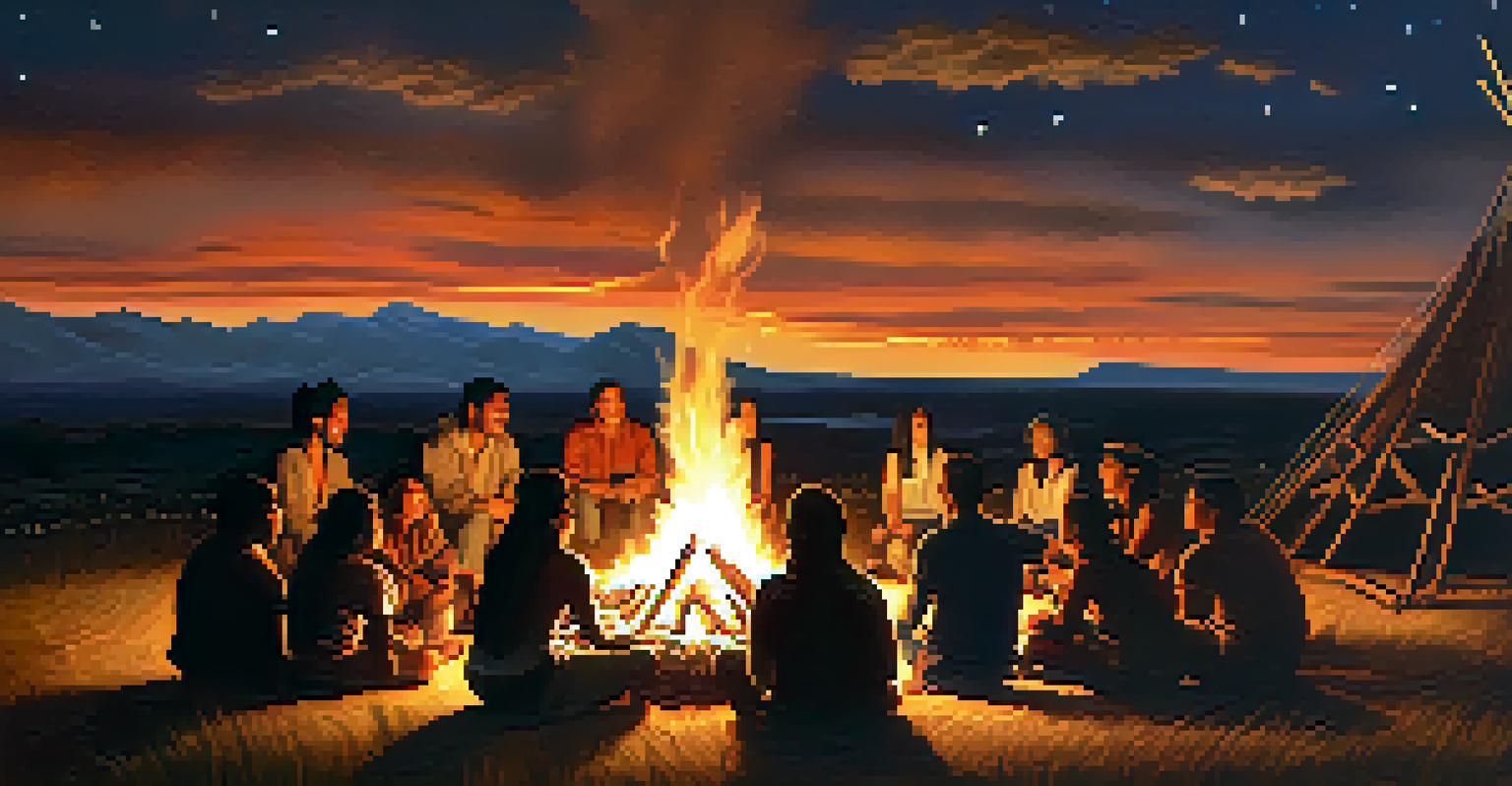Indigenous Cultures and Their Unique Defense Strategies

Understanding Indigenous Cultures and Their Context
Indigenous cultures around the world are rich tapestries of history, language, and traditions. Each community has its own unique way of life that has developed over centuries, deeply connected to the land and its resources. Understanding these cultures is essential to appreciate the defense strategies they employ, as they often stem from their values and worldview.
Indigenous peoples are the original stewards of the land, and their governance systems reflect a deep understanding of the interconnectedness of all things.
For instance, many Indigenous groups see themselves as stewards of the earth, which means their defense strategies often prioritize environmental sustainability. This connection to the land influences how they respond to external threats, whether those are from colonization, resource extraction, or climate change. By recognizing this context, we can better understand and respect their approaches to defense.
Furthermore, Indigenous cultures often rely on oral traditions to pass down knowledge and strategies. This method not only preserves their history but also reinforces community ties, making their defense mechanisms more resilient. Ultimately, these cultural frameworks provide a foundation for their unique defense strategies.
Connection to Land: A Central Defense Element
For many Indigenous cultures, their relationship with the land is sacred and serves as the primary defense against external threats. This connection is not just physical; it encompasses spiritual, social, and economic dimensions. Protecting their land equates to preserving their identity and way of life.

Take, for example, the Māori of New Zealand, who engage in various forms of activism to protect their ancestral lands from development. Their defense strategies include legal battles, public demonstrations, and environmental stewardship, all rooted in their deep connection to the land. This multifaceted approach showcases how the land is integral to their identity and defense.
Cultural Connection Drives Defense
Indigenous communities view their deep relationship with the land as central to their identity and defense strategies.
Similarly, many Indigenous groups in North America use land-based practices, such as traditional farming and hunting, to assert their rights and sovereignty. By maintaining their connection to the land, they not only defend their culture but also promote ecological balance, illustrating how these defense strategies are interwoven with their heritage.
Community Resilience: A Collective Defense Strategy
Community resilience plays a vital role in the defense strategies of Indigenous cultures. Many tribes and communities emphasize collective action, where everyone has a role in safeguarding their heritage and resources. This sense of unity amplifies their efforts and strengthens their resolve against external pressures.
The land is not just the place we live; it’s a part of who we are. When we protect our land, we protect ourselves.
For instance, the Zapatista movement in Mexico showcases how Indigenous communities come together to resist systemic oppression. Their defense strategies include establishing autonomous governance and promoting local agricultural practices. This collective approach not only defends their rights but also fosters a sense of empowerment among community members.
Moreover, the importance of storytelling and communal gatherings cannot be overstated in these defense strategies. By sharing experiences and knowledge, communities reinforce their identity and build a stronger front against adversities. The power of community becomes a formidable defense mechanism in the face of challenges.
Legal Defenses: Navigating Modern Challenges
In an era where legal frameworks often dictate the fate of Indigenous lands, many cultures are increasingly turning to legal defenses as a strategy to protect their rights. Indigenous groups are utilizing international treaties and national laws to assert their claims and fight against injustices. This approach highlights the importance of legal awareness and advocacy in their defense strategies.
A notable example is the Delgamuukw case in Canada, where the Gitxsan and Wet'suwet'en nations fought for recognition of their land rights. The case set a precedent that affirmed Indigenous land rights within Canadian law, showcasing how legal avenues can empower communities. Such victories can significantly alter the landscape of Indigenous rights and defenses.
Community Resilience is Key
Collective action and unity among Indigenous groups empower them to effectively resist external pressures.
However, the legal battles are often complex and lengthy, requiring significant resources and community commitment. Yet, these efforts are vital as they establish a framework for future generations to defend their rights, making legal advocacy an essential component of modern Indigenous defense strategies.
Cultural Revitalization as a Defense Mechanism
Cultural revitalization is another critical defense strategy for Indigenous communities. By reclaiming and promoting their languages, traditions, and practices, these groups reinforce their identity and resilience against external influences. This revitalization acts as a bulwark against cultural erosion and helps maintain their unique heritage.
For example, many Indigenous communities in Canada are actively working to revitalize their languages through educational programs and cultural workshops. This commitment to language preservation is not just about communication; it embodies their history, values, and connection to the land. The act of speaking their language is a powerful form of resistance and defense.
Additionally, cultural festivals and events serve as platforms for sharing traditions and fostering community pride. These gatherings not only strengthen internal bonds but also educate outsiders about their rich heritage. By celebrating their culture, Indigenous groups assert their identity and create a robust defense against cultural assimilation.
Environmental Defense: Protecting Sacred Lands
Environmental defense is a cornerstone of many Indigenous cultures' defense strategies, as their survival often hinges on the health of their ecosystems. Many Indigenous peoples view environmental stewardship as a sacred duty, leading to sustainable practices that protect their lands and resources. This holistic approach emphasizes the interconnectedness of all living things.
The struggle of the Standing Rock Sioux Tribe against the Dakota Access Pipeline is a prime example of environmental defense. Their fight was not just about protecting the land; it was about safeguarding water sources and preserving cultural heritage. This movement highlighted how environmental issues are deeply intertwined with Indigenous rights and identities.
Education Empowers Future Generations
Integrating traditional knowledge with modern education equips Indigenous youth to advocate for their rights and heritage.
By advocating for the protection of their sacred lands, Indigenous communities not only defend their physical surroundings but also promote broader environmental justice. This strategy showcases their role as caretakers of the earth and emphasizes the importance of preserving ecosystems for future generations.
Education and Advocacy: Empowering Future Generations
Education plays a critical role in empowering Indigenous youth to continue the fight for their rights and heritage. By integrating traditional knowledge with contemporary education, Indigenous communities are equipping the next generation with the tools to advocate for their culture. This strategy not only fosters pride but also prepares them to navigate modern challenges.
Many Indigenous-led educational initiatives focus on teaching language, history, and cultural practices, ensuring that young people understand their roots. This knowledge is vital for maintaining cultural continuity and resilience. Programs that emphasize mentorship also help bridge the gap between generations, reinforcing community bonds.

Furthermore, advocacy training is becoming increasingly important, as young Indigenous leaders learn to navigate legal systems and engage in activism. By empowering youth through education, these communities are laying the groundwork for a robust defense against ongoing threats, ensuring that their voices are heard and respected.